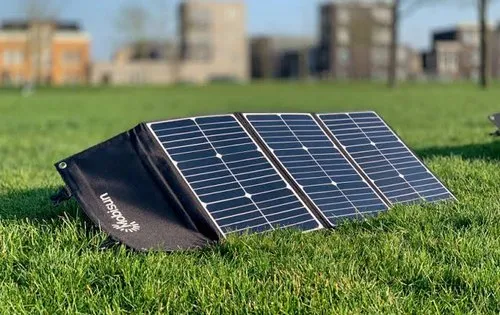Foldable solar panels offer incredible convenience for camping, RV trips, and emergency power, but their portable nature raises important questions about durability. Many users wonder what happens if they accidentally step on their solar panel – will it survive? While manufacturers design these panels to withstand some rough handling, they’re not indestructible. The consequences of stepping on your panel depend on several factors including the panel’s construction, your weight, and how the pressure was applied. Some panels might emerge unscathed from minor incidents while others could suffer permanent damage. In this article, we’ll explore the real-world effects of stepping on foldable solar panels, how to assess potential damage, and practical tips to keep your investment safe.
Can Stepping on a Foldable Solar Panel Damage It?
How Much Weight Can Foldable Solar Panels Handle?
Most quality foldable solar panels can temporarily support between 50-100 pounds when the weight is evenly distributed across the entire surface. However, this doesn’t mean you should treat them like stepping stones. The actual weight tolerance depends heavily on the panel’s construction – models with rigid backing boards and reinforced hinges handle more stress than ultra-thin designs. For example, briefly standing with both feet spread apart might not cause immediate damage to a sturdy panel, but jumping or putting all your weight on one foot could be disastrous. It’s worth noting that while some panels might physically survive being stepped on, the internal solar cells could still suffer micro-fractures that aren’t visible to the naked eye but significantly reduce efficiency.
Common Types of Damage from Stepping on Panels
Stepping on a solar panel can cause several types of damage, some immediately visible and others that develop over time. The most obvious damage includes cracked solar cells, which appear as spiderweb-like lines across the panel’s surface, and bent frames that prevent proper folding. Less visible but equally concerning are delamination issues where the protective layers separate, allowing moisture to seep in, and micro-fractures in the solar cells that reduce power output without visible signs. The junction box (where cables connect) is particularly vulnerable to cracking if stepped on directly. Even if the panel seems fine initially, repeated stress can weaken adhesives and protective coatings, leading to premature failure months later.
Signs Your Solar Panel May Be Compromised
After any incident where your panel was stepped on, watch for these warning signs: reduced power output compared to previous performance under similar sunlight conditions, visible cracks or creases in the surface material, difficulty folding the panel smoothly, or unusual hot spots when the panel is in use. You might notice water condensation forming between layers after rain, indicating compromised seals. Some panels develop “dead zones” where certain sections stop working entirely. If your panel makes new creaking sounds when folding or shows bulges in the surface, these suggest structural damage that could worsen with time.
How Does Stepping on a Solar Panel Affect Its Efficiency?
Impact on Solar Cell Integrity and Power Output
Solar cells are delicate semiconductor devices that rely on uninterrupted electron flow to generate electricity. When stepped on, the pressure can create microcracks that disrupt this flow, similar to how a cracked mirror distorts reflections. Even tiny fractures can significantly reduce output because solar cells are typically wired in series – damage to one cell affects the entire circuit. You might notice your panel still charges devices but takes much longer than before. In severe cases, damaged cells can create resistance points that actually drain power from undamaged sections, causing the entire panel to underperform. The effect becomes more pronounced in low-light conditions where every bit of cell efficiency matters.
Long-Term Wear and Tear from Repeated Stress
A single careful step might not destroy your panel, but repeated stress causes cumulative damage that shortens its lifespan. Each incident weakens the protective layers that shield solar cells from moisture and UV degradation. The flexible substrates in foldable panels are particularly vulnerable to “material fatigue” – think of how repeatedly bending a paperclip eventually makes it break. Over time, stressed areas may develop hot spots where electricity meets resistance, potentially creating fire hazards. The stitching or adhesive bonds in foldable models can separate after repeated stress, leaving gaps where water and dust enter. What begins as minor cosmetic damage can evolve into major functional problems months down the road.
What to Do If You’ve Already Stepped on Your Solar Panel?
Immediate Steps to Assess Damage
If you’ve accidentally stepped on your solar panel, first inspect it carefully in good lighting. Lay it completely flat and examine both sides for visible cracks, creases, or deformation. Check if it still folds smoothly without resistance. Test its output by connecting it to a power meter or observing charging speed with a familiar device under consistent sunlight. Pay attention to any unusual heat coming from specific spots during operation. If possible, compare its performance with an identical undamaged panel under the same conditions.
When to Repair vs. Replace a Damaged Panel
Minor cosmetic damage that doesn’t affect performance or weather resistance may not require immediate action, though you should monitor the panel closely. If you notice reduced output but the panel remains physically intact, consider professional assessment – some specialized repair shops can replace individual damaged cells. However, if the panel shows structural damage affecting its folding mechanism, has visible cell fractures covering more than 10% of the surface, or demonstrates significant performance drops (more than 20% output loss), replacement is usually more cost-effective than repair. Water intrusion damage is particularly problematic as it tends to spread and corrode internal components over time. When in doubt, consult the manufacturer’s warranty terms – some cover accidental damage while others specifically exclude it.
Conclusion
While modern foldable solar panels are surprisingly resilient, they’re not designed to withstand regular foot traffic. The best approach is prevention – always store panels safely and establish clear rules about keeping them off the ground when in use. If an accident does occur, prompt assessment and appropriate action can minimize long-term consequences. For those seeking particularly durable options, EcoFlow’s portable solar panel is renowned for their rugged construction and reliable performance, backed by strong warranties and excellent customer support. Remember that treating your solar equipment with care ensures it will continue providing clean energy for all your adventures.
Keep an eye for more latest news & updates on Touch Cric!

